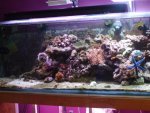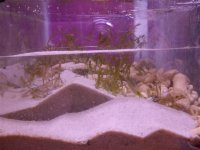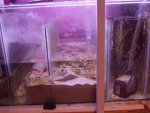Hello all, My LFS guy has told me to slowly take out the coral rubble in my sump as i load more live rock into the tank as he says that the rock will take over the removal of bactreia from the water,as well as having filters etc, Is he right? he tells me that the rock will release nitrogen gas etc that will leave through the water surface and deal with some waste. products. also i have been growing calerpa in the sump to help with nitrates etc.i have some pics for you to look at , Thanks, Blue tang :mrgreen:
You are using an out of date browser. It may not display this or other websites correctly.
You should upgrade or use an alternative browser.
You should upgrade or use an alternative browser.
bacteria
- Thread starter Blue Tang
- Start date
A
Anonymous
Guest
Blue Tang":7kfx4pga said:Hello all, My LFS guy has told me to slowly take out the coral rubble in my sump as i load more live rock into the tank as he says that the rock will take over the removal of bactreia from the water,as well as having filters etc, Is he right? he tells me that the rock will release nitrogen gas etc that will leave through the water surface and deal with some waste. products. also i have been growing calerpa in the sump to help with nitrates etc.i have some pics for you to look at , Thanks, Blue tang :mrgreen:
Sorry, I didn't see this until now. Yes, he is correct to a point, the rock provides bacterial action, the filters provide mechanical filtration, meaning they remove the excess waste before it can break down into pollutants (if you clean the filters properly and regularly). Here's an exerpt from an article here in our library on how the nitrogen cycle works.
A cycle is a process whereby bacteria are shifting their populations in both total numbers and in population types to deal with new food sources. When a tank is new and live rock has just been added, the die-off from the rock breaks down and releases ammonia. That ammonia is taken up by one type of bacteria and given off as nitrite. The nitrite goes through the same process and then is released as nitrate. Those processes happen in the presence of oxygen. Deep in the sand and rock, another type of bacteria exist in low oxygen areas that convert the nitrate to nitrogen. Nitrogen is completely non-toxic and can leave the system as a gas. That is the way in which our tanks cycle. If you start a tank with cured live rock (if truly cured and lacks large clumps of plant or sponge or the like material), then no cycle may be witnessed. If livestock is added slowly, the bacterial populations increase on demand without stressing the system.
Ammonia and nitrite are highly toxic compound generated from decaying matter and from fish waste. If a tank has any detectable ammonia or nitrite, you should not have any living animals present. Ammonia is more toxic in saltwater than in freshwater due to the higher pH of saltwater.
Our recommendation in this day and age is to NOT use livestock of any form to induce a cycle in a tank. Use live rock, cured or uncured, it matters not. Do NOT use dead animals either, it's the same reason. They are both methods from the past that have no place in today's reefing world. Forcing a cycle is not a real benefit if you stock slowly and properly and monitor a young reef tank. Many even believe that no swimming animals should be added until after a few months have passed. More on that later. The reason that you need no more than live rock is twofold: first, the rock already has a full complement of the bacteria you will need to get the tank going and secondly, there is enough 'matter' on the rock to provide 'food' for the bacteria that are the reason your tank is cycling.
http://www.reefs.org/library/newbieguide.html
Many thanks for your reply, i forgot to mention that last week i had a new tank full of water replaced from a guy who supplies new saltwater from the goldcoast in Brisbane, he charged me $80 for 700 ltrs of water he says i should do this every six to eight weeks? What do you think? Blue Tang.
A
Anonymous
Guest
An expensive way to do it, in the long run, plus natural seawater has challenges all its own if it's not first filtered. You're probably better off investing in an RO filter, which will pay you back in a few months.
A
Anonymous
Guest
I agree with the esteemed Ape, that is pretty expensive. Pardon my ignorance, but is salt mix readily available where you are? If so, it's got to be cheaper.
A
Anonymous
Guest
You're welcome!








